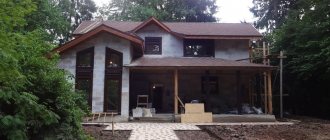Nowadays, there are many different ways to improve the territory in a private or country house, or simply in a country house. Most owners want to make their territory beautiful, but at the same time very compact and unique. The most optimal and acceptable option for landscaping your territory is paving slabs.
Of course, laid paving slabs in your yard will bring joy and delight for many years. However, the quality of tile laying is not unimportant.
You can call a good specialist who will do this work quickly and efficiently, but you can also do this work yourself. Therefore, if you decide to improve your territory yourself, this article will help solve this problem.
Material advantages
Paving slabs are considered the most popular finishing material when arranging the territory, as well as when laying out various paths. At the same time, the tile has a number of positive characteristics due to which it is in high demand.
- does not require special skills and knowledge, so you can lay the tiles yourself without turning to specialists.
- There is a large selection of tiles of various shapes, colors and structures. All this will mainly help bring any design idea to life, while the tiles fit well on the site.
- has increased resistance to wet conditions, while the tiles are not at all afraid of water and other precipitation.
- has a long service life. The material used to make paving slabs can withstand enormous loads for decades, but the tiles will not lose their performance properties.
- ease and convenience of repair work. The main feature of repair work is that if somewhere in a certain area there is a damaged tile, then in this case there is no need to repair a large area. In this case, it is enough to remove the damaged tile and replace it with a new one; almost anyone can cope with this task.
- The material used to make any tile is highly environmentally friendly, so it will not have a harmful effect on human health, this is important.
Flaws:
- laying paving slabs has a high cost of work, although not very significant.
- It requires using quite a lot of material to lay tiles, and it will also take a lot of time.
- With complex design work, it is not always possible to do such work yourself, so here you will need the help of a professional craftsman. Services of this kind will require additional costs.
Therefore, when choosing a tile, you need to take into account all the pros and cons, think through all the nuances well, and only then make a definite choice.
Requirements
Taking into account the functions performed, the covering of the blind area must meet the following requirements:
- Waterproof and moisture resistant. The coating must provide the necessary tightness.
- Sufficient mechanical strength, ensuring the ability to walk on the blind area and resistance to unexpected falls of various objects (for example, icicles).
- Resistance to temperature changes, sufficient frost resistance and resistance to solar ultraviolet radiation.
- Attractive appearance, in harmony with the interior of the facade.
The current SNiP imposes requirements on the design of the blind area itself . It should not have a flat surface and be adjacent to the foundation wall.
At the same time, a compensation gap must be provided to level out thermal expansion and the influence of soil swelling.
The blind area must have a slope to allow moisture to drain. It is laid in a continuous strip around the entire structure, with the exception of the porch.
In addition, the blind area must be wide enough for passage and installation of stairs. No heat should be lost through this element, which means that the problem of its insulation needs to be solved.
Preparation for installation
Before starting work, you need to proceed to the main stage, this is preparing the area for the future placement of the tiles. So, at the preparatory stage, the first thing you need to do is remove the turf to a depth of no more than 20 cm. Next, this space needs to be cleaned, as well as various roots of plants or trees, and stones removed.
But if the soil at the intended location for laying tiles has clayey soils, then a drainage system will need to be installed here. This is very simple to do, just build a small slope along which all the water from the coating will flow down the slope.
Next, you will need to tamp the prepared area where you plan to lay the tiles. You can, of course, make a homemade tamper from a small log and a smooth board, but it is still better to use a tamper. After this, you will need to make in-depth grooves where curbs or side stones will be installed.
Next, an important point is to make a special concrete cushion. This cushion is designed so that side stones or curbs can be installed on it. After the pillow is ready, it is necessary to lay out ready-made crushed stone or small stones. Then you can smoothly move on to the work of preparing the base.
So, at this stage you need to make a sand powder about 10 cm thick. However, many people prefer crushed stone that has a fine fraction, perhaps this is a good option, but it is most preferable to use sand.
It happens when the area where the tiles are planned to be laid has slightly heaving or wet soil, then in this case it is necessary to use special geotextiles, which must be laid in several dense layers. The next stage is adding crushed stone. In such work, it is recommended to use crushed stone with a fraction size of no more than 20 mm.
In this case, the layer of backfill on the ground should not exceed more than 20 cm. After the crushed stone is strewn on the prepared area, it must be well moistened with water, and then compacted well, preferably using a tamper.
Dimensions
The tiles are produced in the following formats:
- 50 by 50 cm. This size is used not only for decorating paths or large areas. Often used as a blind area around the perimeter of a building. To avoid cracks, the surface for laying this coating must be well prepared, otherwise it may burst.
- 40 by 40 cm. Used mainly for decorating paths and surrounding areas.
- 10 by 20 cm or 10 by 10 cm. Imitation of paving stones. It is mainly used to decorate sidewalks and squares. Can be used instead of asphalt covering on roads and parking lots.
- The height varies from 5 to 12 cm. It all depends on the production technology. The greater the height, the stronger the material, but the higher the price.
Below you see how the paving stones lie in the courtyard of a private house in the photo below.
Main stages
Lay the tiles calmly, without rushing, and make sure that they are laid evenly. If there are deviations in the evenness of the installation, it is necessary to correct them and ensure that the tiles are laid evenly. For example, if the tiles have fallen below the required level, then you need to add a little sand or a special mixture of sand and cement and lay the tiles.
But if the tile is higher than the required level, in this case it is necessary to use a rubber hammer designed for this purpose. It is enough to knock on the tile without applying much force. It is necessary to check the evenness of the installation using a regular building level, but of a long length.
After the tiles have been laid, they must be compacted well. Here it is necessary to use a gasoline tamper, thanks to which the surface of laying the tiles will be perfectly smooth and even.
The drainage of water from the surface of the tile is not unimportant. Therefore, during the process of laying tiles, you need to ensure that there is a slope from the central part to the edges.
At the final stage, the surface of the tile must be sprinkled with a special mixture based on cement and sand. This is done to prevent the seams between the tiles from clogging. And all excess mixture must be removed from the surface of the tile, and after that, the entire surface must be watered. Next, the mixture will harden and you can walk on the finished path.
Rolled lawn: types, lawn laying and care- Design of the porch of a private house - ideas for beautiful design in 2021 (131 photos)
Metal tile Monterrey - A beautiful and inexpensive option for arrangement (60 photos)
Types of paving slabs
Paving slabs differ not only in manufacturing technology, but also in the composition and shape of the block. Patterns imitating various materials are often applied to the surface. From imitation marble to the texture of parquet boards. Below are the main types of this building material. For possible options for laying such paving stones, see the photo in our gallery.
Clover shape
The material from which bars of this shape are made is concrete, which contains fine granite crushed stone. Has a smooth surface. Easy to clean, moisture resistant. The patterns for laying paving stones come out in very beautiful shapes.
English cobblestones
Obtained through the process of vibratory casting of concrete mortar. Very similar in shape and color to natural stone. Usually has a gray or brown color. It turns out beautiful paving slabs.
Wave
An elongated block with a bend similar to a wave or lightning, due to which the probability of the bars shifting in the horizontal direction is minimal.
Look at the original design of paving slabs in a private house in the photo.
Brick
As the name suggests, the block is very similar to a brick. The same elongated and regular shape. The most popular and cheapest type. It has high strength and long service life. Below you can see a drawing of brick paving stones.
Galvanized
Tiles with rounded edges. Although the assembly strength of a structure made from such slabs is low and the design possibilities are limited, it is still very popular. The shape of the slabs itself is very aesthetic and the design looks very original. Often this material is coated with a pattern of paving stones with an imitation of marble.
See the photo for types of laying such paving stones.
Installation nuances
Perhaps for some, the process of laying tiles will seem easy and quick, but this is far from what it seems. Everything is much more complicated, since there are very important points in the installation process. So, let's look at them:
- It is recommended to lay the tiles diagonally. In the process of parallel laying of tiles, a large percentage of waste appears, which greatly affects the financial component.
- To give the tiles a certain shape or borders, they need to be trimmed; for these purposes it is recommended to use a special gas cutter, but you can use a regular grinder with a special disc.
Work period
It is recommended to do the blind area after the foundation has been erected and its concrete has gained strength . So she will begin to protect him from the very beginning, because the construction of the house can take a long time.
However, a decorative blind area made of paving slabs can be installed after construction is completed, which will prevent it from being damaged during the construction of walls and roofs.
In winter, you should not make a blind area . Frozen soil cannot be compacted well, and when it thaws, it may sag. The best period for work is dry, warm weather.
Which pattern should I choose?
This question is probably faced by all owners who decide to decorate the road with an interesting pattern. Any paving is painstaking work, even if you work according to a diagram or lay out a simple pattern.
It’s important to decide right away, because you definitely don’t want to lay the tiles again.
It is worth choosing a paving scheme based on factors such as:
- landscape;
- site architecture;
- place of installation;
- dimensions and configuration of the site.
- Usually, based on all these factors, not only the pattern is chosen, but also the thickness of the tiles. The paved road will remain with you for a long time, because the average service life is 40-50 years. A paved road with a creative tile pattern will not only create a pleasant impression, but will also “model” the space around it, visually expanding or narrowing it.
- If you plan to beautifully decorate the space under or around any building, it is best to lay paving stones in a circle. This way the building itself will be in the center, and it will be much more convenient to approach it. It would be logical to make a parking space or next to a playground in a retro style using thick bricks. This will not only look beautiful, but will also make cleaning the area easier.
For a path between trees or in a garden, the classic method is more suitable.
Curly elements
Any buyer of paving slabs will certainly face the problem of choice. It’s good when the client knows exactly why he came, it’s worse when there is no such understanding, but the wealth of choice makes his eyes dazzle.
The shapes of paving slabs can be different, but the most popular types are:
- Paving stones;
- Gzhelka;
- Wave;
- Honeycomb;
- Clover;
- Runo and others.
To improve the performance of tiles, manufacturers often add granite chips. In this case, granite tiles will be the best option for laying roads.
DIY making
You can also make paving slabs yourself to reduce construction costs . The simplest, casting method is carried out as follows.
Molds are made (wooden or metal) that exactly follow the shape of the tile. A solution is poured into them, pre-mixed thoroughly, with a fairly thick consistency. Drying is ensured within 60-70 hours.
Then, the mold with the contents is immersed in heated water for about 30-40 s, which makes it possible to easily remove the workpiece. The tile is placed on a flat, horizontal surface and aged for 23-25 days.
Recommended solution composition:
- cement grade not lower than M400 (20%);
- sifted river sand (55%);
- crushed stone fraction 6-10 mm (22%);
- fiber fiber (4% by weight);
- plasticizer (0.5% by weight);
- dye for concrete (up to 7%).
The water is cleared of all impurities and amounts to 6-7%. For 1 m3 of mixture, 135 liters of water are recommended.
The highest quality and most durable tiles are obtained using the vibration method. However, this requires special equipment. The molds are installed on a vibrating table, which ensures the necessary compaction of the mixture.











